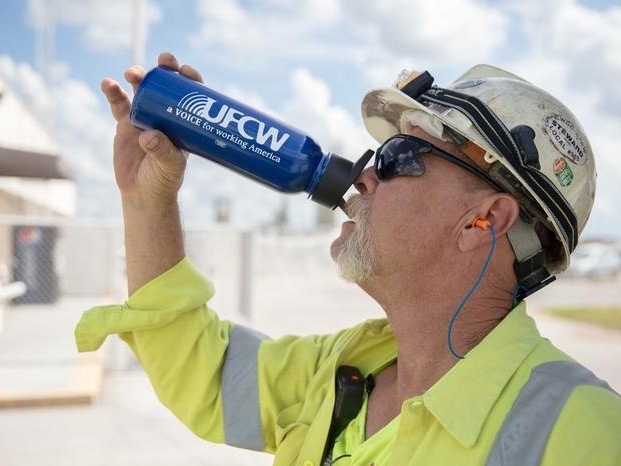The UFCW’s Occupational Safety and Health (OSH) Office has guidelines to help locals protect our members from the risk of heat illness this summer.

With outside temperatures soaring, the use of personal protective equipment (PPE) to keep our members safe from COVID-19 increases the chances of overheating. The use of PPE may trap heat and perspiration on the body’s surface and increase the core body temperature to dangerous levels. Given the dual challenge of moderating the risks of heat stress and exposure to COVID-19, it’s imperative that employers take measures to protect workers who are exposed to heat. For example, employers need to supply replacement cloth face masks more often, since masks may get damp and contaminated in the heat and humidity, making it difficult to breath.
To prevent heat illness, employers should make sure all workers should have access to:
• Adequate amounts of drinking water.
• Regular rest breaks or rest periods in a cool area.
• Regular bathroom breaks, as necessary.
• Increased air circulation through the use of air conditioning, fans and general ventilation.
• Education on the early signs of heat-related illness.
• Time to acclimatize to the heat. It takes about one week for the body to adjust to working in the heat. New workers should be given time to get used to working in high heat areas. During their first two weeks, they should be monitored for signs of heat illness and provided extra breaks until they have adjusted to the heat.
• Cloth face masks that are made out of breathable, moisture-wicking materials to stop the spread of COVID-19.
Hot weather safety strategies should include:
• Training all management and hourly employees with an emphasis on how to recognize a medical emergency (heat stroke).
• Having a clearly written protocol on how to respond to a medical emergency.
• Training all management and hourly employees on workers’ right to access drinking water, as needed, and the right to access bathrooms, as needed.
• Monitoring particularly hot work areas and a plan in place for when the heat index approaches the extreme caution zone.
• Monitoring the use of face masks for workers who work in hot and humid conditions or perform strenuous activities outdoors and allowing workers to remove face masks when they can safely maintain at least six feet of physical distance from others.*
*The Centers for Disease Control and Prevention (CDC) mask guidelines are subject to change. Local unions should check both the Occupational Safety and Health Administration (OSHA) and CDC websites for updated guidance.
Two major heat-related illnesses are heat exhaustion and heat stroke. Heat exhaustion, if left untreated, may progress to deadly heat stroke. The symptoms of heat exhaustion and heat stroke are listed below:
Symptoms of Heat Exhaustion
- Headache, dizziness or fainting
- Weakness and wet skin
- Irritability or confusion
- Thirst, nausea or vomiting
Symptoms of Heat Stroke
- May be confused, unable to think clearly, pass out, collapse or have seizures (fits)
- May stop sweating
“With the arrival of the summer months, excessive heat becomes an even more serious and sometimes an unfortunate fatal workplace hazard,” said OSH Office Interim Director Roy McAllister. “It is so important that we continue to push our employers to take the necessary precautions and provide the necessary protections for all workers.”
OSHA quick cards about preventing heat stress at work are available in English and Spanish. For more information about heat and heat-related illness, please have your Region Director contact Roy McAllister, the interim director of the OSH Office, at rmcallister@ufcw.org.
